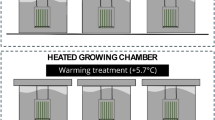Abstract
Release of14C-labelled carbon dioxide from uniformly labelled cells was used to measure respiration by individual ciliates in 2-h incubations in 1989 and 1990. In a strictly heterotrophic ciliate,Strobilidium spiralis (Leegaard, 1915), release of labelled carbon dioxide was equivalent to ca. 2.8% of cell C h−1 at 20°C, and there was no difference between rates in the dark and light. In the chloroplast-retaining ciliatesLaboea strobila Lohmann, 1908,Strombidium conicum (Lohmann, 1908) Wulff, 1919 andStrombidium capitatum (Leegaard, 1915) Kahl, 1932, release of labelled carbon dioxide was less in the light than in the dark in experiments done at 15°C. InL. strobila release of radiolabel as carbon dioxide was equivalent to ca. 2.4% of cell C h−1 in the dark but ca. 1% at 50µE m−2 s−1, an irradiance limiting to photosynthesis. InS. conicum release of radiolabel as carbon dioxide was equivalent to ca. 4.4% of cell C h−1 in the dark, but at an irradiance saturating to photosynthesis (250 to 300µE m−2 s−1) there was no detectable release of labelled carbon dioxide. InS. capitatum release of radiolabel as carbon dioxide was equivalent to ca. 4.3% of cell C h−1 in the dark but at an irradiance saturating to photosynthesis was ca. 2.4% of cell C h−1. These data, combined with data from photosynthetic uptake experiments, indicate that14C uptake underestimates the total benefit of photosynthesis by 50% or more in chloroplastretaining ciliates.
Similar content being viewed by others
Literature cited
Beardall, J., Raven, J. A. (1990). Pathways and mechanisms of respiration in microalgae. Mar. microb. Fd Webs 4: 7–30
Blackbourn, D. J., Taylor, F. J. R., Blackbourn J. (1973). Foreign organelle retention by ciliates. J. Protozool. 20: 286–288
Caron, D. A., Goldman, J. C., Fenchel, T. (1990). Protozoan respiration and metabolism. In: Capriulo, G. M. (ed.) Ecology of Protozoa. Oxford Univ. Press, New York, p. 307–322
Dodge, J. D. (1979). The phytoflagellates: fine structure and phylogeny. In: Levandowsky, M., Hutner, S. H. (eds.) Biochemistry and physiology of Protozoa, 2nd edn., Vol. 1. Academic Press, New York, p. 7–47
Fenchel, T. (1987). Ecology of Protozoa. Science Tech Publishers, Madison, Wisconsin
Guillard, R. R. L. (1975). Culture of phytoplankton for feeding marine invertebrates. In: Smith, W. L., Chanley, M. H. (eds.) Culture of marine invertebrate animals. Plenum Publishing Co., New York, p. 29–60
Ikeda, T. (1979). Respiration rates of copepod larvae and a ciliate from a tropical sea. J. oceanogr. Soc. Japan 35: 1–8
Jonsson, P. R. (1987). Photosynthetic assimilation of inorganic carbon in marine oligotrich ciliates (Ciliophora, Oligotrichina). Mar. microb. Fd Webs 2: 55–68
Kawakami, R., Ayukai, T., Taniguchi, A. (1985). A preliminary report on respiration rates of two tintinnid species (Ciliata). Bull. Plankton Soc. Japan 32: 171–172
Klekowski, R. Z. (1981). Size dependence of metabolism in protozoans. Verh. int. Verein. Limnol. 21: 1498–1502
Laval-Peuto, M., Rassoulzadegan, F. (1988). Autofluorescence of marine planktonic Oligotrichina and other ciliates. Hydrobiologia 159: 99–110
Laval-Peuto, M., Salvano, P., Gayol, P., Greuet, C. (1986). Mixotrophy in marine planktonic ciliates: Ultrastructural study ofTontonia appendiculariformis (Ciliophora, Oligotrichina). Mar. microb. Fd Webs 1: 81–104
Manahan, D. T. (1983). The uptake and metabolism of dissolved amino acids by bivalve larvae. Biol. Bull. mar. biol. Lab., Woods Hole 164: 236–250
Prézelin, B. B., Putt, M., Glover, H. E. (1986). Diurnal patterns in photosynthetic capacity and depth-dependent photosynthesisirradiance relationships inSynnechococcus spp. and larger phytoplankton in three water masses in the Northwest Atlantic Ocean. Mar. Biol. 91: 205–217
Putt, M. (1990). Metabolism of photosynthate in the chloroplast-retaining ciliateLaboea strobila. Mar. Ecol. Prog. Ser. 60: 271–282
Putt, M. (in press). Abundance, chlorophyll content and photosynthetic rates of ciliates in the Nordic Seas during summer. Deep-Sea Res.
Putt, M., Stoecker, D. K. (1989). An experimentally determined carbon:volume ratio for marine “oligotrichous” ciliates from estuarine and coastal waters. Limnol. Oceanogr. 34: 1097–1103
Rogerson, A., Finlay, B. J., Berninger, U.-G. (1989). Sequestered chloroplasts in the freshwater ciliateStrombidium viride (Ciliophora: Oligotrichida). Trans. Am. microsc. Soc. 108: 117–126
Schmidt-Nielsen, K. (1975). Animal physiology. Cambridge University Press, London
Stoecker, D. K. (1991). Mixotrophy in marine planktonic ciliates: physiological and ecological aspects of plastid-retention by oligotrichs. In: Reid, P. C., Turley, C. M., Burkill, P. H. (eds.) Protozoa and their role in marine processes. NATO ASI Ecological Series, Vol. 25. Springer-Verlag, New York, p. 161–179
Stoecker, D. K., Michaels, A. E., Davis, L. H. (1987). Large proportion of marine planktonic ciliates found to contain functional chloroplasts. Nature, Lond. 326: 790–792
Stoecker, D. K., Silver, M. W. (1987). Chloroplast retention by marine planktonic ciliates. Endocytobiology III. Ann. N.Y. Acad. Sci. 503: 562–565
Stoecker, D. K., Silver, M. W., Michaels, A. E., Davis, L. H. (1988). Obligate mixotrophy inLaboea strobila, a ciliate which retains chloroplasts. Mar. Biol. 99: 415–423
Stoecker, D. K., Silver, M. W., Michaels, A. E., Davis, L. H. (1988/1989). Enslavement of algal chloroplasts by fourStrombidium spp. (Ciliophora, Oligotrichida). Mar. microb. Fd Webs 3: 79–100
Stoecker, D. K., Taniguchi, A., Michaels, A. E. (1989). Abundance of autotrophic, mixotrophic and heterotrophic planktonic ciliates in shelf and slope waters. Mar. Ecol. Prog. Ser. 50: 241–254
Turpin, D. A., Elrifi, I. R., Birch, D. G., Weger, H.G., Holmes, J. J. (1988). Interactions between photosynthesis, respiration, and nitrogen assimilation in microalgae. Can. J. Bot. 66: 2083–2097
Weger, H. G., Herzig, R., Falkowski, P. G., Turpin, D. H. (1989). Respiratory losses in the light in a marine diatom: measurements by short-term mass spectrometry. Limnol. Oceanogr. 34: 1153–1161
Author information
Authors and Affiliations
Additional information
Communicated by J. Grassle, New Brunswick
Contribution no. 7510 from the Woods Hole Oceanographic Institution
Rights and permissions
About this article
Cite this article
Stoecker, D.K., Michaels, A.E. Respiration, photosynthesis and carbon metabolism in planktonic ciliates. Mar. Biol. 108, 441–447 (1991). https://doi.org/10.1007/BF01313654
Accepted:
Issue Date:
DOI: https://doi.org/10.1007/BF01313654




